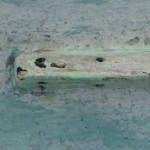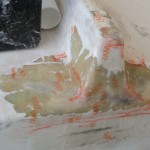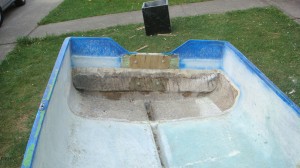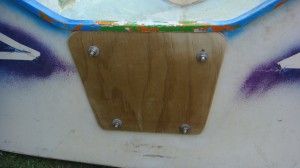So, Along with the few days of sun and work aside, I managed to put a little bit of into the boat.
This edition: Body work.
Cleanup
The rear fin – This required a fair about of chopping back because of the amount of damage from the drop.
Most grinders will work in this situation, however, remember about the balance of power versus handling.
Patchup: Internal Rear Fin
Before being able to do any external work, the inside needed strengthening, however this was also the tricky part because the work needs to be done upside-down to maintain the original shape of the fin.
To account for this I weighed down the boat with a very *convenient* marble table that happened to break with the last big earthquake.

 The internal work called for some quick drying, so instead of making a rock-hard mix, I waited for a nice warm day. This seems to help in terms of the resin having the drying effects of very rich a-mixture.
The internal work called for some quick drying, so instead of making a rock-hard mix, I waited for a nice warm day. This seems to help in terms of the resin having the drying effects of very rich a-mixture.
Patchup: External Rear Fin
After the complete cleanup the fun work begun (fiber)!
The one easy way to avoid a dirty/finish was to keep replacing the brush every hour or so (try those cheap Chinese knock-offs), they work pretty well.
Cleanup: Seat supports
Like every boater will tell you before purchasing a new boat, take an expert along. That is what I did not do.
Note the condition of the supports before beginning work on them:
Hope you love tedious gentle cleanup.


Repair: Seat Supports
Be weary of what you remove from the compromised fiber, you will need anything that will deteriorate, however make sure you leave enough to mold your new fiber over.
Surrounding paint was removed for good contact with the hull. Sorry I was not about to take pictures of the application of fiber. The pictures below show the product cleaned up and with the first layer of fiber.
Cleanup: Outboard Mount
The boat originally came with some rotting wood the age of your grandpa’. This called for a new engine mount.
In this situation, some treated plywood was just sitting around in the garage – thank you very much – the cheap part.
The expensive part came in the form of a nice set of stainless bolts.
Note the Before picture.
Because I already removed cleared out the rear the opportunity came along to put fix the two bottom bolts in resit + fiber.
Note the two lower bolts just below the new front-facing support.
The end result looks a little something like this.
For us here it is the end of summer so the continuation of this project will have to wait a bit…
Thank you for your time.

























